Hunger, beating, humiliating, working beyond strength, killings. This was everyday life in Nazi and Soviet POW camps during World War II. Can you judge who was more lucky:the captured Germans or the Soviets? And who was more likely to survive and return home?
"Never before have so many prisoners been taken in such a short time in the history of modern wars," wrote the famous American historian Timothy Snyder about Operation Barbarossa. Indeed, after the German aggression against the USSR in June 1941, hundreds of thousands of Soviet soldiers were captured. In the Battle of Smolensk alone, which lasted from July 6 to August 5, 1941, the Wehrmacht captured 346,000 of them.
Another 665,000 Red Army soldiers found themselves in camps in September, after the Germans had captured Kiev. In October, in the double battle of Vyazma and Bryansk, the Soviet losses amounted to 673,000 prisoners. By the end of 1941, about three million Soviets had been captured by the Germans. It is estimated that by the end of the war, the Germans captured them - a trifle - almost 6 million !
Wagons full of dead bodies and a camp in the middle of nowhere
According to Hitler's directives during conversations with the generals, Soviet soldiers were treated as subhumans. International conventions on the treatment of prisoners of war were not applied to them. The brutal and inhumane treatment began when the captured were sent to the rear.
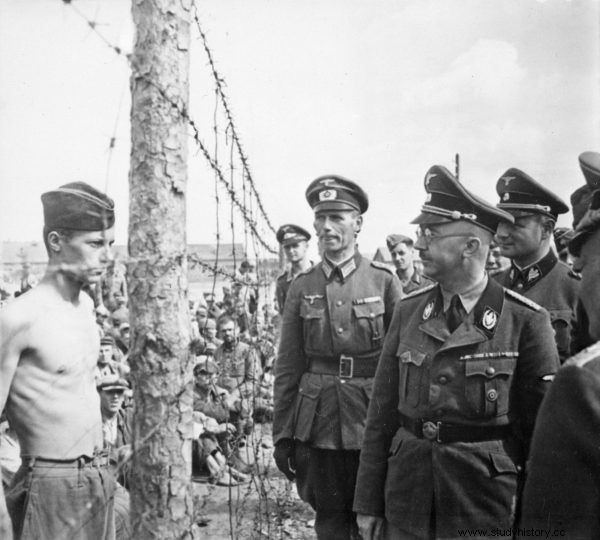
Heinrich Himmler visits a POW camp in 1941.
The soldiers captured in the Kiev cauldron were led without rest for over 400 km. When one of them weakened, a German escort rode a horse and whipped him with a whip, and when it did not work, he reached for a gun. The weak, the sick and the wounded were killed without mercy, leaving their bodies on the road.
The prisoners transported by rail were only slightly more fortunate. They were often transported in open wagons that did not protect against bad weather conditions. In winter, they traveled in unheated freight cars. Dozens of frozen bodies fell out as the trains arrived at their destination. The death rate on the way was 70 percent . It is estimated that about 200,000 prisoners of war died during the marches and transports.
Gehenna did not end with the arrival at the destination. The conditions in the camps were horrible. At the beginning of the German-Soviet war, these were just… pieces of land fenced with barbed wire. There were no barracks, baths or toilets inside, and the prisoners stood or sat on the ground. Various methods were used to survive. In Gomel, three friends tried to keep each other warm while sleeping next to each other. They successively occupied the best place in the middle, where the recliner took advantage of the neighbors' warmth. One who survived told about it years later.
In a dulag (transit camp) 162 in Stalino, 10,000 prisoners of war were crowded in a small space. For lack of space, they all stood. Those who fell were immediately trampled. At least 25,000 people died there. The death rate in stalag 346 in Kremenchuk was also very high. The prisoners were given 200 grams of bread a day at the most. The bodies of the dead were thrown into the pit every morning. It sometimes happened that the living were thrown there too, who, weakened by hunger, did not have the strength to get up . Borys Sokołow, who spent many years in German camps, wrote in his memoir "In captivity":
Every morning you see that almost every barracks have one or several barefoot and undressed bodies collapsed. First, a special commando of gravediggers brings them to the barn turned into a morgue. Then once or twice a day they take the corpses out of the camp and bury them in previously carved pits .
Mice, grass, leaves, colleagues…
Food rations in the camps were minimal and the soldiers were starving. To cheat the stomach, they ate mice, frogs, grass, leaves, bark and pine needles. Prisoners often fought for food; Of course, the stronger and more brutal ones were usually the top players. The hunger was so great that there were even cases of cannibalism. German guards from Stalag 306 in Kirovograd, Ukraine reported that prisoners were eating the bodies of their shot colleagues.
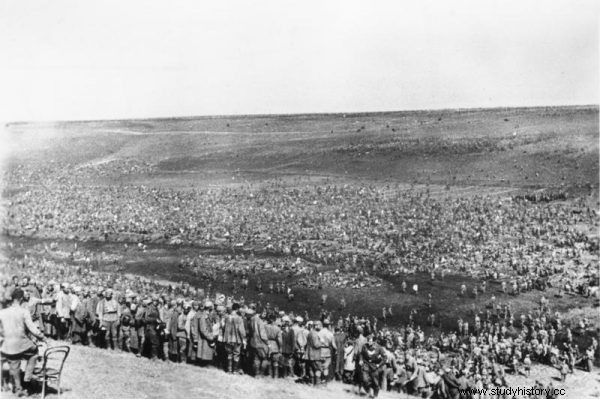
Crowds of Soviet prisoners of war taken prisoner on the Eastern Front in August 1942.
The reports of the cannibalism are also confirmed by the memories of one of the prisoners of the women's camp in Włodzimierz Wołyński. "We, women, saw in advance that many prisoners were eating corpses," Rozalia Wołkowskaya told about what happened in the neighboring Stalag 365. Meanwhile, Sokołow described the conditions in the camp near Salaspils in Latvia as follows:
Sometimes you find corpses with buttocks cut out, or with cuts on the sides. This is the work of the cannibals. The primitive ones cut out the buttocks, those the more sophisticated ones cut the sides and pull the liver out . For this reason, strict ordinances are read all the time, but cannibalism cannot be eradicated .
50,000 one way, 50,000 the other way ...
Why did the Germans treat Soviet prisoners of war so ruthlessly? The goal was clear:to exterminate as many of them as possible. This was what starvation, lack of medical care, terrible living conditions and extra-hard work served for. Some of the prisoners were sent to death at once. In September 1941, special Einsatzkommandos liquidation groups were ordered to select prisoners. It was decided to liquidate party and state officials, political commissioners, intellectuals and Jews. The selections were made superficial, so they killed virtually blindly.
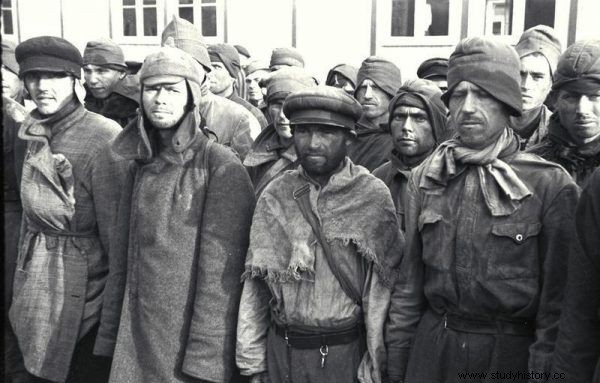
Soviet prisoners of war who came to the Mauthausen concentration camp, October 1941.
In the camp in Chorola, at least 50,000 Soviet Jews and about 50,000 other prisoners of war were shot. The extermination of Soviet prisoners was also carried out in concentration and extermination camps. In Auschwitz, at the beginning of September 1941, several hundred Soviets were gassed experimentally with Zyklon B. In Sachsenhausen, they were gassed with exhaust gases in a truck. A total of about 8,000 were killed in Auschwitz by various methods, 10,000 in Mauthausen, and 18,000 Red Army soldiers in Sachsenhausen.
According to conservative estimates, the Germans shot 500,000 captured Soviet soldiers. Approximately 2.6 million of them died in transit and from starvation. It follows that in total in the German camps up to 3.1 million Soviet prisoners of war may have lost their lives. It must be added that the suffering of those who survived did not end with the return to the USSR after the war. Under Stalin's order, they were considered traitors and sent to labor camps. Together with whole families.
It was better to die
And what was the situation of German prisoners of war in the USSR? The fact that the state had not signed the Geneva Convention of July 27, 1929 "On the Treatment of Prisoners of War" certainly did not give hope. This is what Norman Davies wrote about the Soviet captivity in his book "Europa walczy 1939-1945":
There were approximately 4,500,000 German prisoners of war in the USSR. They were lucky to be caught alive because the Red Army had no qualms about killing the wounded and marauders. But they were left in no doubt that they were collectively to blame for the "fascists" and that they would regret not being killed .
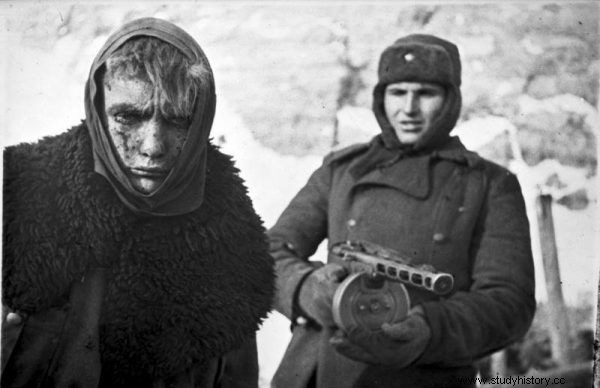
After the surrender of the troops of the Third Reich at Stalingrad, about 100,000 prisoners were captured by the Soviets. The photo shows a Red Army soldier and a wounded German soldier.
Davies' figure is overstated. It is true that when the Soviets began to achieve their first successes, their POW camps were filled with German soldiers. After the Battle of Moscow in early 1942, there were already 120,000. Another 91,000 joined after the surrender of the 6th Army at Stalingrad. In 1944, about 150,000 prisoners of war were taken in Belarus during the Operation Bagration. With each successive Soviet victory, the number of prisoners grew. However, it never reached 4.5 million. In April 1945, there were about 2 million Germans in Soviet captivity, and after the end of hostilities - about 3 million.
The captured Wehrmacht soldiers were driven east, to labor camps in the depths of the USSR. The road resembled that which the Soviet prisoners of war traveled the other way. Soldiers were chased with butts, not always fed, and the weak and late were often killed. Stops took place in random places or in the open air. Such a murderous journey is recalled by Gottlob Bidermann, a soldier of the Courland army, author of the book “In deadly struggle. Diaries of a German soldier from the Eastern Front ”:
Packed like cattle, we were initially kept in open fields or forest clearings. Increasing hunger forced us to desperately try to get nutrition from the grass we found in the fields, or it made us chew the bark of trees in an attempt to suppress the painful hunger cramps that overwhelmed us and weakened us .
In captivity, German prisoners of war were used as labor. They worked in building factories, rebuilding damaged cities, digging canals, deforestation and agriculture. The conditions were tough. They were burdened with work beyond their strength and provided with only small rations, all in an unfavorable climate. Added to this was the brutality of the guards, the lack of medical care and the lack of hope for a return home. As a result, the death rate of German prisoners of war was enormous . Biedermann says:
Working commandos were sent to snowy forests where trees were felled by hand. All this felling work was carried out without the support of any machinery:trees were felled with axes and two-handed saws, and trunks were split using wedges and wooden hammers. The meager food rations did not provide enough calories to cope with this type of strenuous physical work, and soon the first deaths appeared among us .
Richard Overy, a British historian of World War II, estimates that of the 3 million German prisoners held in the USSR, 356,000 lost their lives in one way or another. Other researchers believe that there were many more victims - even 1 million. For example, this is what the German historian Rüdiger Overmans thinks. A similar figure comes from the accounts of the American historian Waitman Wade Beorn, who claims that 35.8 percent of German prisoners of war died in Soviet captivity.
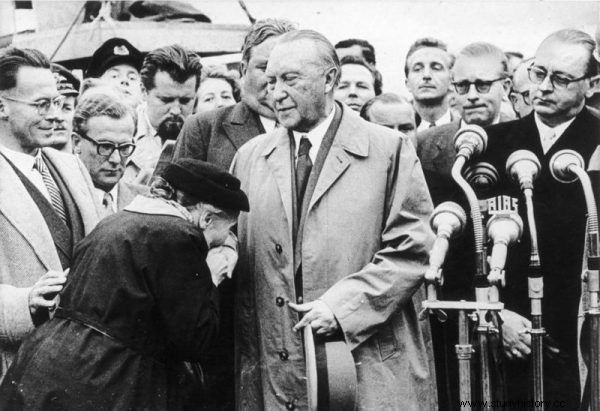
The mother of one of the released prisoners thanks German Chancellor Konrad Adenauer on his return from his official visit to Moscow in 1955.
The Soviet system, however, was not geared - at least theoretically - to the extermination of prisoners. It was planned to use them as free labor, as well as subject them to communist indoctrination. This was done, among others, by the Free Germany National Committee. Bidermann came into contact with its members, calling them unequivocally traitors. So where does the high death rate come from? It resulted from the conditions inherent in the Soviet Union for treating people considered enemies and prisoners.
Going home
The fate of the German prisoners of war in the USSR differed from that of the Soviet prisoners of war in Nazi captivity in another important aspect. The Germans, like prisoners of other nationalities, were released home with time. Already in 1946, 5,000 Austrians and about 5,000 sick and weak Germans were released. Dismissals continued in 1947 and 1948. After the establishment of the German Democratic Republic in October 1949, the Soviets released and repatriated 85,000 prisoners. By 1950, about 500,000 Germans, all Austrians, 100,000 Hungarians, 50,000 Romanians and 150,000 Japanese were released.
However, it was not the end of captivity for everyone. In September 1955, Chancellor of the Federal Republic of Germany, Konrad Adenauer, traveled to Moscow in order to establish diplomatic relations. The agreement signed there also provided for the release of 10,000 German prisoners of war, who were still in Soviet labor camps 10 years after the end of the war. And the last (probably) German prisoner of war in Russia was released in ... July 2014 . It was Reinhard Kinze, 84, a soldier in the 12th SS Panzer Division who was captured in January 1945 during the initial phase of the Battle of Berlin. He spent 69 years in Soviet and Russian camps.
